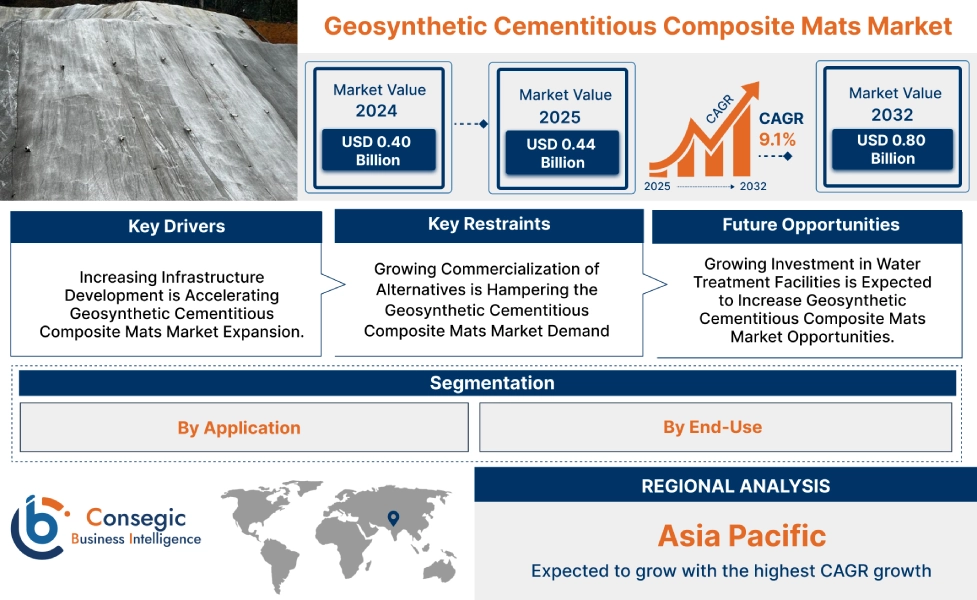Geosynthetic Cementitious Composite Mats Market Size:
Geosynthetic Cementitious Composite Mats Market size is growing with a CAGR of 9.1% during the forecast period (2025-2032), and the market is projected to be valued at USD 0.80 Billion by 2032 from USD 0.40 Billion in 2024. Additionally, the market value for the 2025 attributes to USD 0.44 Billion.
Geosynthetic Cementitious Composite Mats Market Scope & Overview:
Geosynthetic cementitious composite mats (GCCMs) are innovative flexible rolls of fabric. The production process includes infusing a 3D fiber matrix with a dry cement blend. Later, it is packaged in rolls. On-site, it is unrolled and simply sprayed and immersed in water. This fabric hardens and forms a thin concrete layer when they are hydrated with water. It is also waterproof and fire-resistant. Also, their geosynthetic components provide structural integrity. Moreover, it provides high abrasion resistance and excellent durability. They offer quick deployment and reduce labor time. Additionally, they adapt well with complex contours and provide superior erosion control.
How is AI Impacting the Geosynthetic Cementitious Composite Mats Market?
Artificial Intelligence is influencing the geosynthetic cementitious composite mats (GCCM) market by improving the product design, performance monitoring, and production efficiency. AI-driven simulations enable manufacturers to optimize material composition and structural properties, improving durability, flexibility, and environmental resistance. Machine learning algorithms analyze field data to predict wear, erosion, and performance under different soil and weather conditions, ensuring reliable installation outcomes. In manufacturing, AI automates quality control, identifying defects early and minimizing waste. Additionally, predictive analytics support demand forecasting and supply chain planning, ensuring timely delivery for infrastructure and construction projects. As sustainability and precision engineering gain importance, AI is driving smarter, more durable, and cost-efficient advancements in the GCCM market globally.
Geosynthetic Cementitious Composite Mats Market Dynamics - (DRO) :
Key Drivers:
Increasing Infrastructure Development is Accelerating Geosynthetic Cementitious Composite Mats Market Expansion.
Geosynthetic cementitious composite mats provide rapid, durable, and sustainable alternatives to traditional concrete methods. They are used in roads & railways for erosion control on embankments. They are beneficial in rapid repairing the damaged sections of the infrastructure. Moreover, they prevent landslides when applied to natural or engineered slopes. Economic growth, urbanization, and governmental initiatives have led to an increase in infrastructure development, hence requiring these mats for multiple applications.
For instance,
- In 2023, the U.S. federal government directly spent USD 44.8 billion on infrastructure projects. Additionally, the federal government transferred USD 81.5 billion to state and local governments for infrastructure projects, thus positively impacting geosynthetic cementitious composite mats market trends.
Overall, increasing infrastructure development is significantly boosting market expansion.
Rising Mining Activities are Driving the Market
Geosynthetic cementitious composite mats are used in mining for erosion control, slope stabilization, and channel lining. They offer benefits such as faster installation, cost-effectiveness, and durability. Moreover, they minimize risks associated with traditional concrete mixing in remote and difficult-to-access mine sites. Additionally, they provide an abrasion-resistant surface capable of harsh mining conditions. Growing demand for critical minerals needed for the energy transition has led to a rise in mining activities, increasing the need for these mats.
For instance,
- According to the United States Geological Survey, U.S. mineral production added more than USD 105 billion to the U.S. economy, representing a USD 4 billion increase over 2022, thus positively impacting geosynthetic cementitious composite mats market trends.
Overall, rising mining activities are accelerating the global geosynthetic cementitious composite mats market growth.
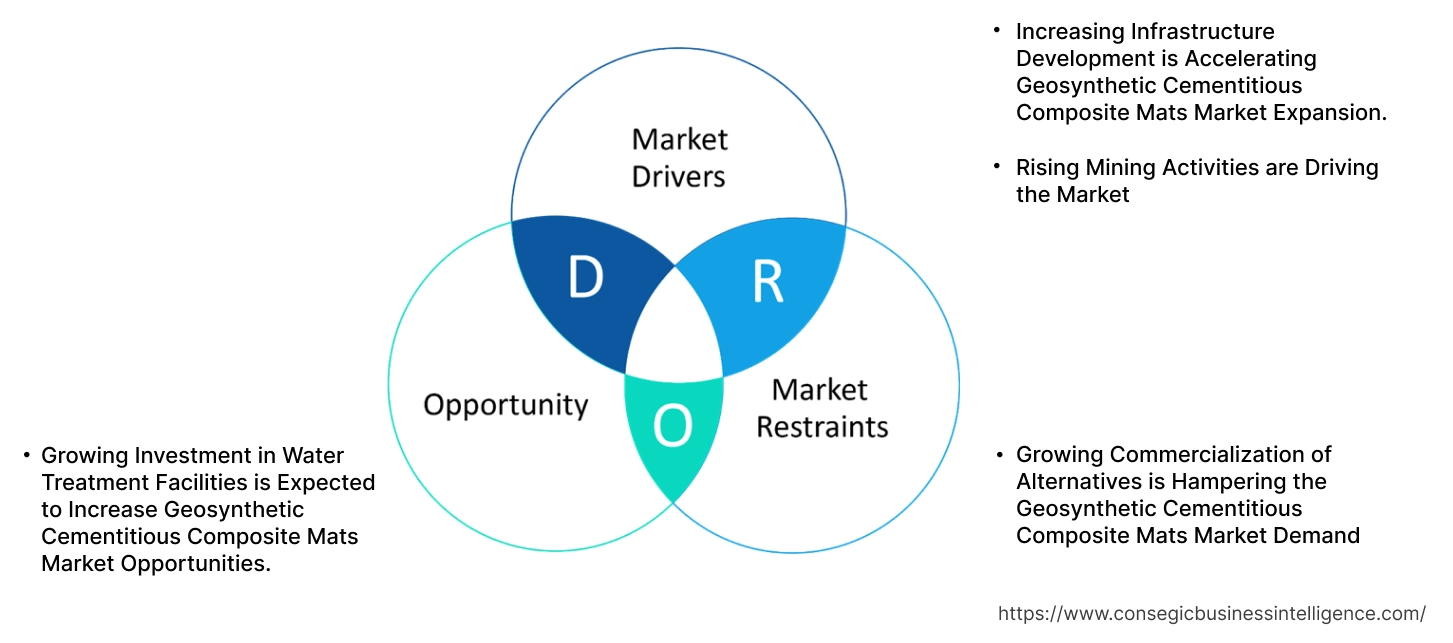
Key Restraints :
Growing Commercialization of Alternatives is Hampering the Geosynthetic Cementitious Composite Mats Market Demand
The market faces competition from other substitutes available in the market. For instance, geotextiles and erosion control blankets are generally more cost-effective for light to moderate erosion control. They are also lightweight and are easily installed without specialized equipment. Also, many are designed to promote vegetation growth. This offers an aesthetically pleasing and environmentally integrated solution. Moreover, shotcrete offers high strength and durability for stabilization in challenging terrains. This includes tunnels and vertical surfaces. Also, it provides structural rigidity and is quickly applied to irregular shapes. This makes it a robust solution where high compressive strength and immediate load-bearing capacity are critical. Hence, the increasing commercialization of alternatives is hampering the geosynthetic cementitious composite mats market demand.
Future Opportunities :
Growing Investment in Water Treatment Facilities is Expected to Increase Geosynthetic Cementitious Composite Mats Market Opportunities.
Geosynthetic cementitious composite mats manage and convey water efficiently. This prevents contamination in the water resources. They are used for lining water channels, canals, and ditches within water treatment plants and municipal water management systems. Moreover, they provide an impermeable barrier to prevent water seepage and erosion along the banks. They are also employed in lagoon and pond lining for various stages of water purification. The government is increasing investment to ensure access to safe drinking, which is leading to increased projects, hence creating potential for these mats.
For instance,
- In 2024, the U.S. government announced a USD 125 million investment for five California and Utah projects aimed at developing new water sources and boosting drought resilience.
Overall, growing investment in water treatment facilities is expected to increase the geosynthetic cementitious composite mats market opportunities.
Geosynthetic Cementitious Composite Mats Market Segmental Analysis :
By Application:
Based on Application, the market is categorized into erosion control & slope protection, channel lining, culvert & spillway protection, pipeline protection, rail & road embankment, containment system, and others.
Trends in Application:
- The rising need for enhanced erosion-resistant surface is influencing the use of GCCM.
- Growing trend for materials that protect buried pipes is influencing the use of GCCM.
The erosion control & slope protection segment accounted for the largest Geosynthetic Cementitious Composite Mats market share of 49.78% in 2024.
- Slopes, embankments, and earthworks are highly vulnerable to erosion from environmental factors such as rainfall, wind, and surface runoff.
- This leads to the loss of soil, undermining structures, and damage to the environment.
- GCCMs provide an innovative solution by being supplied as flexible, fabric-like rolls that when hydrated with water changes into a thin, durable, and resistant or semi-permeable concrete layer.
- This unique characteristic allows them to be used over vulnerable slopes, forming an immediate, erosion-resistant surface that effectively prevents soil wash-out, stabilizes the underlying ground, and disperses the energy of flowing water.
- Manufacturers are introducing novel mats mainly for erosion control and slope protection.
- For instance, Cortex Composites Inc received a patent for Geosynthetic Cementitious Materials Composite Mats for applications such as channel, canal or ditch lining, erosion control and slope protection.
- Thus, as per the market analysis, the growing need for erosion control and slope protection influences the growth of the segment.
The pipeline protection segment is expected to grow at the fastest CAGR over the forecast period.
- Pipeline protection is the fastest growing application for Geosynthetic Cementitious Composite Mats, particularly in the oil & gas, water, and wastewater industry.
- These mats offer an innovative and efficient solution for protecting buried or exposed pipelines from various environmental and operational threats.
- These mats are unrolled and hydrated to form a thin, durable, and flexible concrete layer that encapsulates or covers pipelines.
- This provides robust erosion control, protecting the surrounding soil from scouring due to water flow or wind, which could otherwise expose the pipe.
- Thus, based on the market analysis, as per the aforementioned factors, the pipe protection segment is influencing the market trends.
By End Use:
The End Use segment is categorized into construction & infrastructure, oil & gas, mining, water treatment, agriculture, and others.
Trends in the End Use
- There is a growing trend for reliable and sustainable construction and infrastructure solutions that is influencing the use of geosynthetic cementitious composite mats.
- The growing investment for water treatment projects is driving the use of geosynthetic cementitious composite mats.
The construction & infrastructure segment accounted for the largest geosynthetic cementitious composite mats market share in 2024.
- The Construction and Infrastructure industry stands as the dominant end use for Geosynthetic Cementitious Composite Mats due to their versatility, efficiency, and durability in addressing a wide array of civil engineering challenges.
- This sector includes critical areas such as roads, railways, bridges, tunnels, flood protection systems, and general urban development.
- Geosynthetic Cementitious Composite Mats are extensively utilized for erosion control and slope stabilization along highway embankments, rail lines, and waterway banks, providing immediate and long-term protection against scour and weather.
- The rise in investment for infrastructure development is influencing the use of these geosynthetic mats.
- For instance, the data by IBEF states that Ministry of India has approved 50 National Highway projects spanning 1,026 km in Manipur, with 44 projects covering 902 km located in the hills.
- Thus, as per the market analysis, the growing investment for various infrastructure development projects is influencing the segment share.
The water treatment segment is expected to grow at the fastest CAGR over the forecast period.
- Geosynthetic Cementitious Composite Mats are widely utilized for lining canals, ditches, and ponds used for water conveyance, storage, or wastewater containment.
- It provides a durable, low-permeability barrier that prevents seepage and minimizes water loss.
- They are also used for erosion control and slope protection around water treatment lagoons, sedimentation basins, and reservoir banks, protecting these critical structures from hydraulic scour and environmental degradation.
- The rapid installation reduced logistical footprint, and long-term durability of GCCMs make them an attractive alternative to traditional concrete.
- As a result, owing to the aforementioned factors, the water treatment segment is expected to be lucrative over the forecast period.
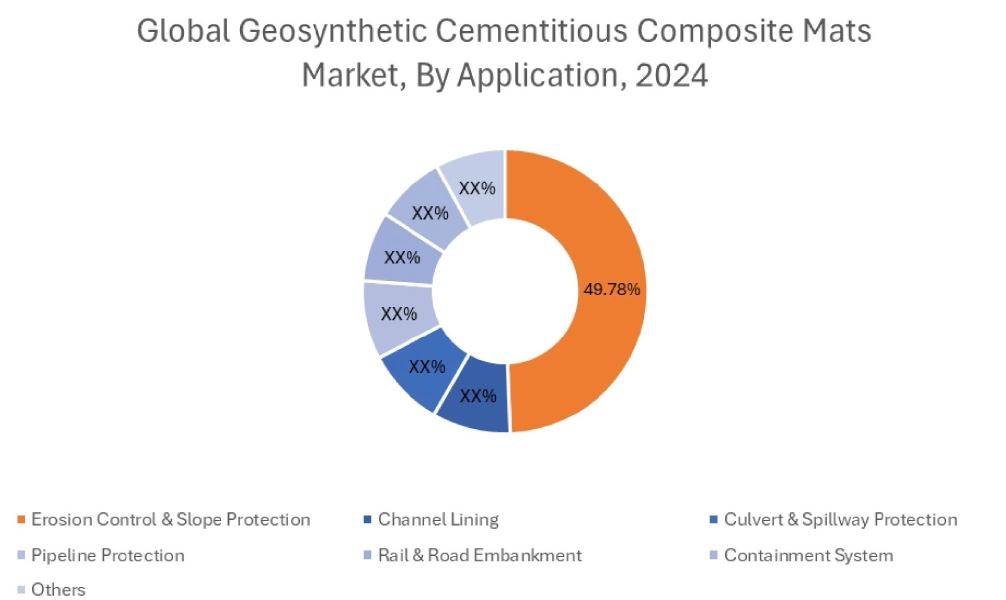
Regional Analysis:
The regional segment includes North America, Europe, Asia Pacific, the Middle East and Africa, and Latin America.
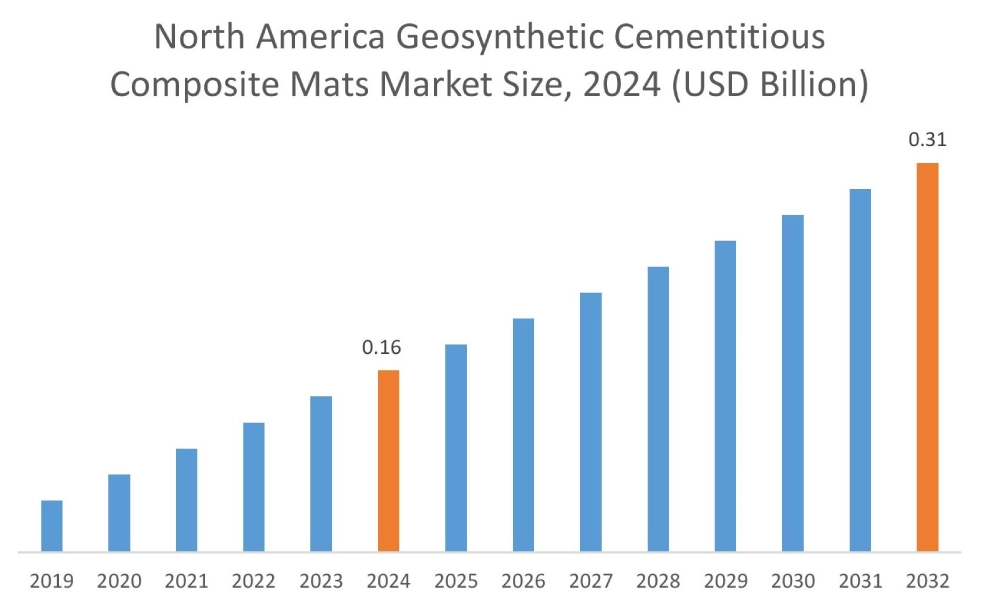
In 2024, North America accounted for the highest market share at 41.03% and was valued at USD 0.16 billion and is expected to reach USD 0.31 billion in 2032. In North America, U.S. accounted for the market share of 72.39% during the base year of 2024. North America focuses on infrastructure rehabilitation, a strong emphasis on sustainable construction practices, and the demand for rapid and cost-effective solutions. Geosynthetic Cementitious Composite Mats offer a highly effective alternative to traditional concrete for crucial applications such as erosion control and slope stabilization along highway embankments, railway lines, and riverbanks. The ability of GCCMs to be rapidly unrolled and hydrated on-site, along with their flexibility and resistance to various environmental factors, makes them ideal for addressing North America's extensive infrastructure upgrade requirements. The growing investment for development of new infrastructure is influencing the use of Geosynthetic Cementitious Composite Mats.
For instance,
- The data by American Road & Transportation Builders Association, states that United States have received USD 15.9 billion in the first three years of the IIJA’s new USD 27.5 billion formula bridge program and have committed 46 percent of these resources to over 4,170 bridge projects.
Thus, as per the market analysis, the rise in the infrastructure development projects is influencing the geosynthetic cementitious composite mats market growth in this region.
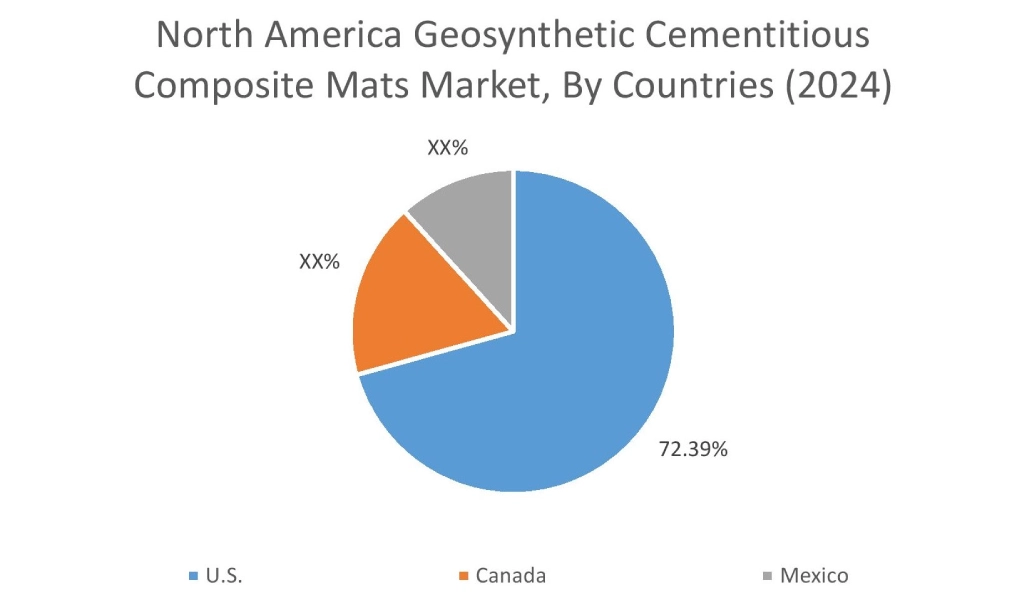
In Asia Pacific, the Geosynthetic Cementitious Composite Mats industry is experiencing the fastest growth with a CAGR of 10.8% over the forecast period. The rapid urbanization, industrial growth, and the growing need for efficient and sustainable water management solutions are the factors driving the use of geosynthetic cementitious composite mats. These mats are utilized in various water treatment facilities for erosion control along the banks of reservoirs, canals, and waterways, preventing soil loss and maintaining water quality. Additionally, they provide effective containment systems for industrial wastewater treatment ponds, preventing leaks and protecting the surrounding environment. Thus, as per the geosynthetic cementitious composite mats market analysis, the above-mentioned factors are contributing to the market trends in this region.
In Europe, substantially there is a rise in mining operations. These operations include the extraction of a variety of resources including minerals, coals and others. The geosynthetic cementitious composite mats are mainly used in mining for erosion control, and channel lining among others. Factors such as the increasing requirement for raw materials along with the growing focus on energy transition are increasing the mining activities in this region, thereby directly having a positive impact on the market demand.
Latin America is a vital food producer, but it generally faces issues such as soil erosion, scarcity, inefficient irrigation systems, and the impacts of climate change like increased instances of floods and droughts. Geosynthetic Cementitious Composite Mats are potentially being utilized for irrigation canals and ditches, significantly reducing water speed and improving the efficiency of water delivery to crops. Additionally, they provide effective erosion control and slope protection on agricultural land, preventing soil loss on sloped fields or along watercourses. Thus, as per the Geosynthetic Cementitious Composite Mats market analysis, the growing government initiatives and agricultural practices are contributing to the market opportunities in the region.
The Middle East and Africa regions have extensive networks of pipelines, well pads, storage facilities, and processing plants, that are situated in remote, arid, or coastal environments prone to erosion, extreme temperatures, and potential spills. Geosynthetic Cementitious Composite Mats provide numerous advantages for these applications. They offer rapid and cost-effective erosion control around pipeline routes, preventing soil loss and ensuring the stability of critical infrastructure. Thus, the use of this material is contributing to the Geosynthetic Cementitious Composite Mats market expansion in this region.
Top Key Players & Market Share Insights:
The Geosynthetic Cementitious Composite Mats market is highly competitive with major players providing products to the national and international markets. Key players are adopting several strategies in research and development (R&D) and product innovation to hold a strong position in the global Geosynthetic Cementitious Composite Mats market. Key players in The Geosynthetic Cementitious Composite Mats industry include-
- Titan Environmental (Canada)
- Concrete Canvas Ltd. (United Kingdom)
- Ocean Non Wovens Pvt Ltd (India)
- Amplified Concrete Solutions Global, LLC (United States)
- Terrafix Geosynthetics (Canada)
- Geofabrics Australasia Pty Ltd. (Australia)
- PGATECH Group (Philippines)
- Changzhou Pioneer Textile Technology Co., Ltd. (China)
Geosynthetic Cementitious Composite Mats Market Report Insights :
| Report Attributes | Report Details |
| Study Timeline | 2019-2032 |
| Market Size in 2032 | USD 0.80 Billion |
| CAGR (2025-2032) | 9.1% |
| By Application |
|
| By End Use |
|
| By Region |
|
| Key Players |
|
| North America | U.S. Canada Mexico |
| Europe | U.K. Germany France Spain Italy Russia Benelux Rest of Europe |
| APAC | China South Korea Japan India Australia ASEAN Rest of Asia-Pacific |
| Middle East and Africa | GCC Turkey South Africa Rest of MEA |
| LATAM | Brazil Argentina Chile Rest of LATAM |
| Report Coverage |
|
Key Questions Answered in the Report
How big is the Geosynthetic Cementitious Composite Mats market? +
In 2024, the Geosynthetic Cementitious Composite Mats market is USD 0.40 Billion.
Which is the fastest-growing region in the Geosynthetic Cementitious Composite Mats market? +
Asia Pacific is the fastest-growing region in the Geosynthetic Cementitious Composite Mats market.
What specific segmentation details are covered in the Geosynthetic Cementitious Composite Mats market? +
Application and End Use segmentation details are covered in the Geosynthetic Cementitious Composite Mats market.
Who are the major players in the Geosynthetic Cementitious Composite Mats market? +
Titan Environmental (Canada), Concrete Canvas Ltd. (United Kingdom), Terrafix Geosynthetics (Canada), Geofabrics Australasia Pty Ltd. (Australia), and PGATECH Group (Philippines) are some major players in the market.
